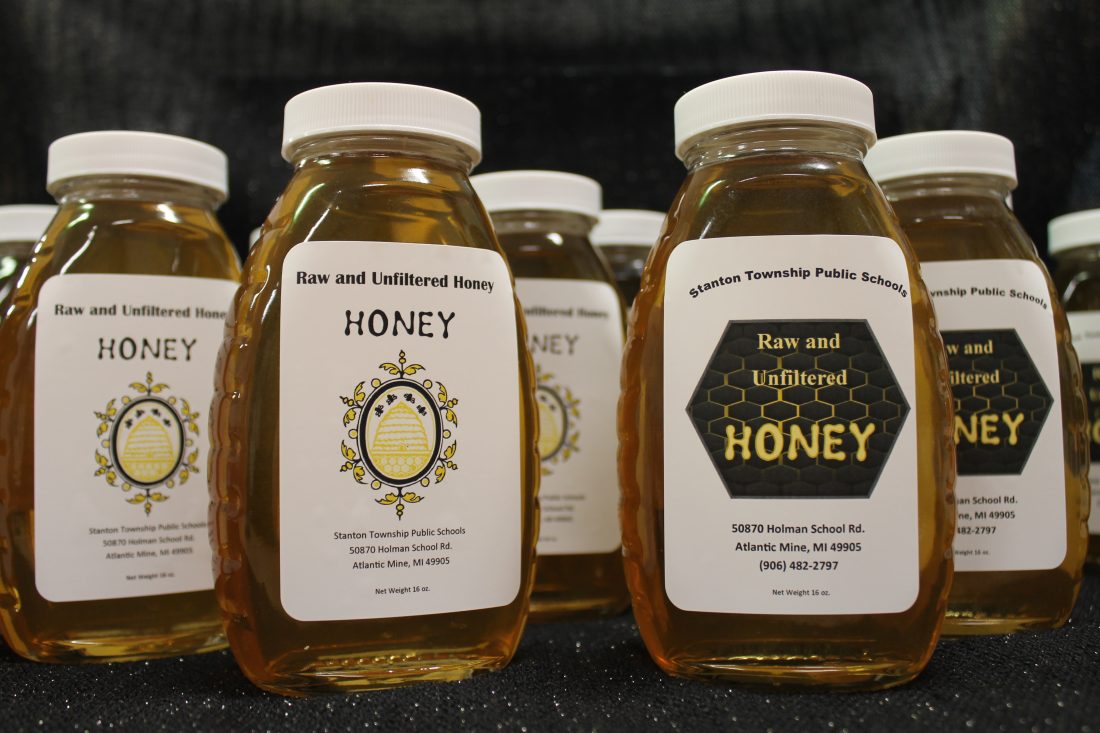E.B. Holman School: It’s more than just the bees

STANTON TOWNSHIP — Through a Lake Superior Stewardship Initiative (LSSI) project, middle-school student at the E.B. Holman School this month extracted 31.5 pounds of honey, which they filtered and bottled, from two bee hives. The bee hives are located in the newly fenced garden area of the school yard.
Lloyd Wescoat, who is the head of K-12 Education Programming at the LSSI Center for Science and Environmental OutreachGreat Lakes Research Center,at Michigan Technological University, said that while not this is not the first year for bee-keeping at the school, it is the first year there was enough honey for a harvest.
Community partners Dave and Cathy Caspary, of the Caspary farm, have guided the grade 6-8 students and teachers in their beekeeping learning adventure. They have taught lessons to the students, and have worked along side teachers in the bee yard, giving expert advice from beginning to end, said Wescoat, on how to start the hive from beginning to end, on how to start the hive, right through how to extract honey and overwinter bees.
For two years, E.B. Holman student/teacher teams has been fortunate enough to have different community partners, Wescoat said. Kathleen Harter and Todd Gemelli taught the basics of beekeeping and fostered the school’s first hives at their farm.
“The beekeeping community lends support to learners at all stages of the process,” said Wescoat, “and E.B. Holman has benefitted from that time and again.”
Wescoat said that with the supply chain interrupted due to the COVID-19 pandemic, some essential tools necessary to honey extraction sill have not arrived, so local beekeepers stepped in, loaning equipment and providing ideas for emergency substitutes. In spite of remote learning, canceled events, disrupted schedules and new learning protocols, students were still able to extract nearly 40 lbs. of honey. But these challenges did not stop the program. One recent at-home assignment was design a new label for next year’s honey jars.
The desire for a school yard beehive came 10 years ago, Wescoat said, when three teachers visited an apiary on Beaver Island. While learning about the role of pollinators in the ecosystem, the declining of bees was also discussed.
“It fit into E.B. Holman’s long-term Lake Superior Stewardship Initiative project,” she said, “focusing on using land in a way that supports food production and utilizes watershed responsibility.”
In addition to the beehives, the fenced in garden also has raised beds, an orchard and a greenhouse. Funding for the garden has come from support from the Portage Health Foundation and the LSSI, Wescoat said. Project activities in addition to beekeeping include school-wide composting, outdoor classroom, disc golf course, geology walkway, and K-8 bird studies.
“All projects reflect interdisciplinary grade-level learning standards,” said Wescoat. “Students design models to help create solutions to real-world issues, and older students present findings and lessons to younger students in the school.”
The LSSI projects include:
• school gardens
• bee hives
• school wide composting
• outdoor classroom
• disc golf course
• geology walkway
• school-wide bird studies
The lead teachers Jean Dunstan, Deirdre Erbisch and Mike Hainault, followed by Chris Rebman, and Principal/Superintendent, James Rautiola.
Community Partners include:
• Green Timber Consulting Foresters, Inc.
• Grandpa’s Barn
• Copper Country Audubon Society Ecologist
• KBIC Natural Resources Department
• Beekeepers: Kathleen Harter & Todd Gemelli
Dave and Cathy Caspary of Caspary Farms






